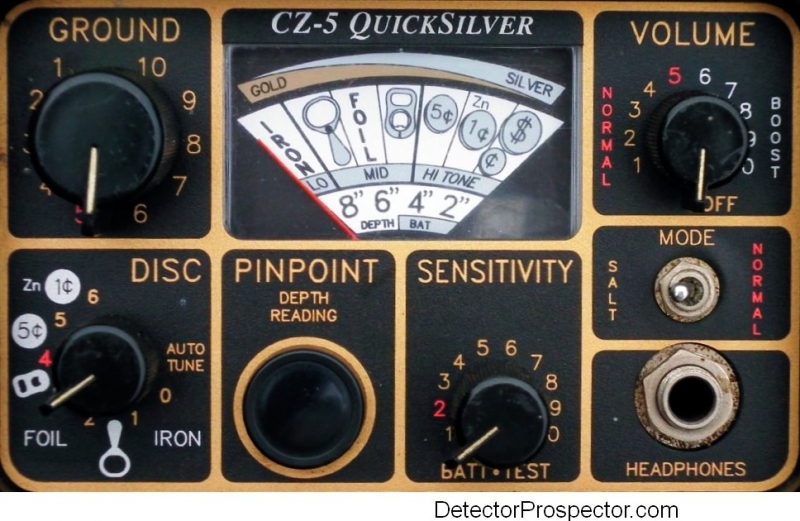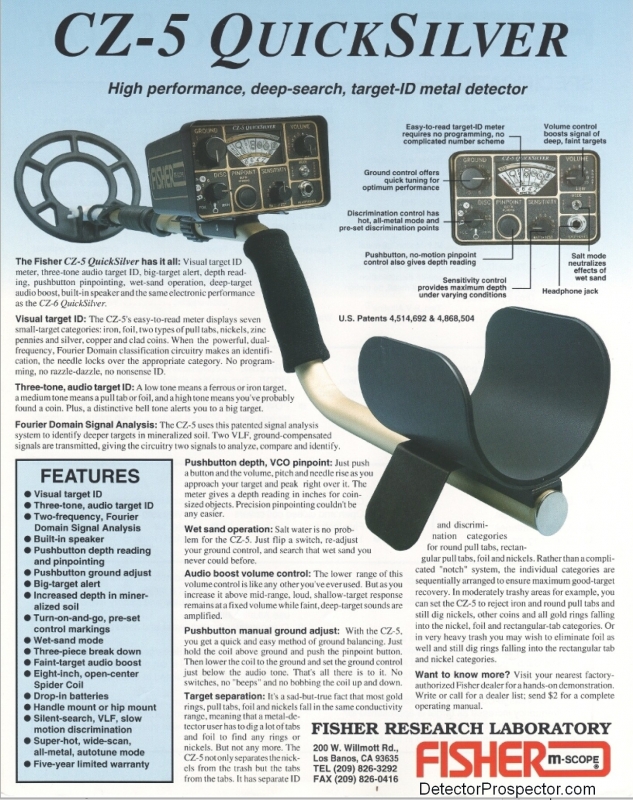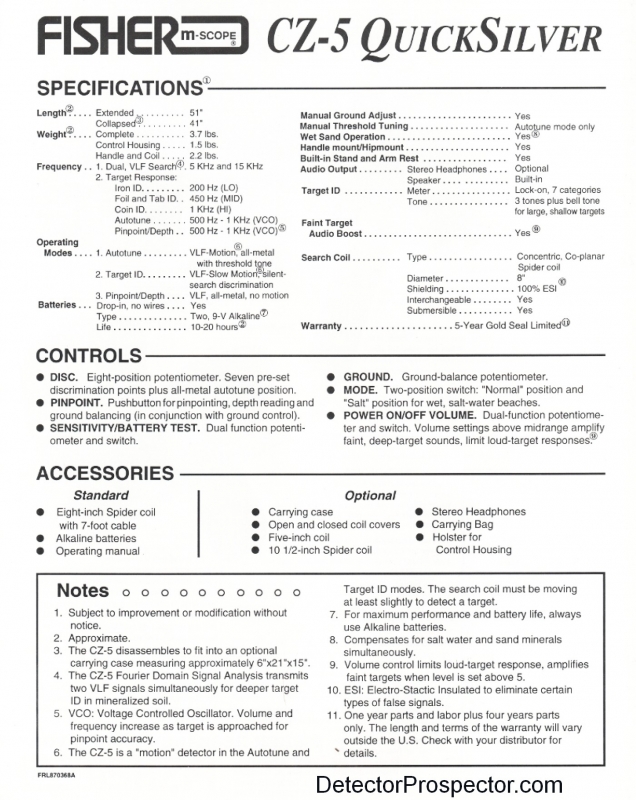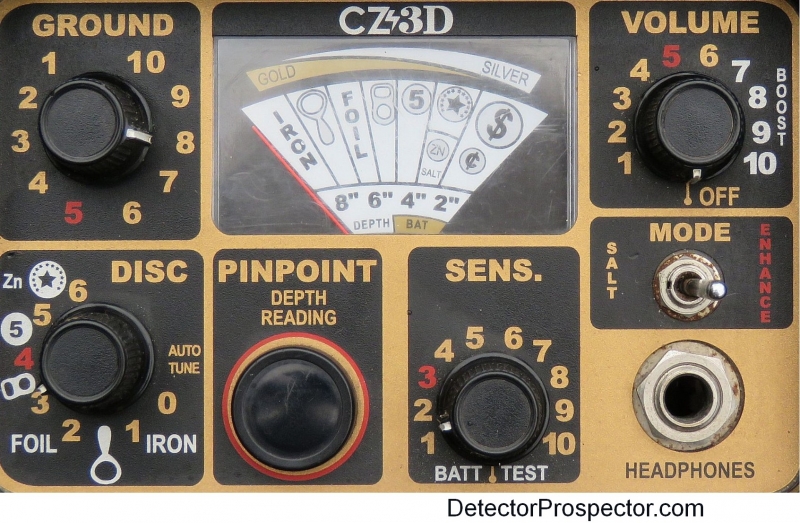-
Posts
19,768 -
Joined
Content Type
Forums
Detector Prospector Home
Detector Database
Downloads
Everything posted by Steve Herschbach
-
On Tuesday, August 29, 2017, History Seekers welcomes guest Thomas Boykin, project manager, of White's Electronics, Inc. We will be discussing what detectorist want to see in the next generation of metal detectors. This is a great opportunity for loyal listeners from all experience levels to have input. Get your questions and suggestions ready, due to call volume time will be limited to approximately 30-40 seconds. Tune in live on Agust 29 at 9:00 PM Eastern / 8:00 PM Central directly from our web page under the media section (historyseekers.net) OR directly via www.spreaker.com/historyseekers How to win the White’s MX SportBe sure to like the History Seekers and White's Electronics, Inc. Facebook page to stay up to date on this show! Thomas Boykin from White’s Electronics will be on the show Tuesday, August 29, 2017 to talk about your suggestions as well as to give away an MX SPORT! Here is how to enter to win: 1. Go over to the Whites web page and request a free catalog. Be SURE to enter a valid email (must be the same email used to submit step 2). Request here: www.whiteselectronics.com/request-catalog 2. Submit your suggestion for features/abilities that you would like to see on your next detector. You must submit a brief suggestion to info@historyseekers.net . You must also include your correct shipping name/address/telephone number (contact info in case you win) 3. You can make multiple suggestions but only ONE entry is counted for the drawing. 4. All entries must be received at least 3 hours prior to the start of the History Seekers Show (9:00 PM EST) to be entered in the contest. We will be talking about suggestions made and taking callers to discuss your thoughts on them on air. A winner will be announced by White’s at the end of the History Seekers show. If the announced winner did not properly qualify a runner up will be chosen later at the discretion of White’s Electronics. In the event that the show must be rescheduled for any reason, the contest would be rescheduled and announced later. This contest is not connected with Facebook. It is free to enter with no purchase necessary and void where prohibited. If you would always like to see these types of contests be sure to click on History Seekers and Whites Facebook page then click the follow and select see first. This will ensure that you always get notified of events on both pages.
-

XP Deus For Beach Hunting?
Steve Herschbach replied to MontAmmie's topic in Metal Detecting For Jewelry
I do that sort of stuff all the time and sure would enjoy hearing your report. All single frequency detectors struggle with salt water. Little known fact is salinity levels vary at different beaches around the country. I get the impression the AT Pro is borderline, and works ok at some beaches but not well at others. One goal in the AT Max was attempting to address this issue. Were it not for the Minelab announcement I would lean AT Max myself. However, with the AT Max now delayed until sometime in September it would be nuts to not wait and have Minelab show their hand before making any decisions. -

New Patch Gives Gold X 2
Steve Herschbach replied to Deft Tones's topic in Metal Detecting For Jewelry
Got yo love those plain 14K gold bands - I am wearing one right now I found detecting, one of many. Just goes to show though that the real secret to detecting is patience and getting in the hours - now go find some more! -
That's awesome Peg. Great gold and great photos - you are living the dream!
-
Welcome to the forum! There are plenty of people using VLF detectors to find gold. I have found several ounces of gold with the F75 myself http://www.fisherlab.com/hobby/finds-Steve-Herschbach.htm The F75 is a close relative of the Teknetics T2, which has been sucessfully used to find gold nuggets around the world, especially in Africa. The fact is I can find gold quite well with any modern VLF detector running at over 12 kHz that has a ground balance setting. "This VLF versus that VLF detector" is not as important as learning the VLF you have well and putting yourself on gold bearing ground - and getting in the hours. I have found significant amounts of gold with the following VLF detectors: Compass Gold Scanner Pro, Fisher Gold Bug, Fisher Gold Bug 2, Fisher F75, Makro Gold Racer, Minelab XT 17000, Minelab Gold Monster 1000, Nokta FORS Gold, Tesoro Lobo, White's Goldmasters/GMT, White's MXT I suppose I should go find some gold nuggets with the Nokta Impact and post them just to show it can be done. Maybe next trip. Anyone choosing to use a detector not made and marketed specifically for nugget detecting has to get used to being lonely on the forums. It's not that the machines are not capable, but that people are just naturally going to tend to use detectors made for coin hunting to hunt coins and detectors made for nugget detecting to hunt gold nuggets. In general however you will get an edge gold prospecting by using detectors made specifically for the task. The most important function on most coin, jewelry, and relic detectors is some sort of discrimination capability. Nugget detectors focus purely on finding low conductive targets in highly mineralized ground. What discrimination they offer, if any, is usually a secondary consideration.
-
The GM1000 should handle all but soaking wet saltwater sand. Auto sensitivity is your friend!
-

Gold Monster / Golden Mask Rod Adaptation
Steve Herschbach replied to Steve Herschbach's topic in Minelab Metal Detectors
-

Rye Patch Sweat ( Sweet ) Hunt!
Steve Herschbach replied to LuckyLundy's topic in Detector Prospector Forum
Nice nugget - anything 1/4 oz and larger is a significant find these days! The big ones are fewer and farther between. -
Metal detector models are years in the pipeline, so companies are responding to each other far less than people imagine. Things more often than not appear simply because they finally got done enough to release, nothing more. First Texas has a large engineering staff, and if you add Bounty Hunter, Fisher, and Teknetics up they have not been lacking for "new" detectors. Admittedly however most seem to just be older models under a new label i.e. Fisher F70 rebranded as Teknetics Patriot. 2006 - Teknetics T2 2007 - Fisher F75 2008 - Fisher F70 2010 - Fisher Gold Bug (Digital) 2014 - Fisher F19 Most models since 2006 seem to be variants of these and other existing models.
-
The SDC "limited depth" thing is simply because it has an 8" hardwired coil. However, that coil should punch up to between one and two feet depending on the size of the target. Larger target equals more depth. The SDC should hit a 1/4 ounce U.S. nickel size gold nugget at about a foot. Don't expect anything but a fairly large size nugget (or beer can) in excess of a foot.
-

XP Deus 74 Khz Elliptical Coil - I'm Impressed!
Steve Herschbach replied to Steve Herschbach's topic in XP Metal Detectors
-
That's a shame. Seems like I just got my Gold Monster and it's already obsolete. The Nokta Impact is also "the most powerful all-around metal detector ever made!" Nothing like over the top marketing Timing is everything however and there is no doubt Fisher being late to market has left room open for the Garrett AT Max and whatever Minelab has up their sleeve. There appears to be nothing else on the horizon for the fall.
-

Never Before - White's Discount Coupon
Steve Herschbach replied to Mark Gillespie's topic in White's Metal Detectors
White's has always had coupons for various package deals. They have however become more aggressive about directly contacting customers via email etc. offering various discounts and deals. -

Bigfoot Coils On Ebay
Steve Herschbach replied to Mike Hillis's topic in Metal Detecting For Jewelry
Looks like Jim's original notebooks with secrets of Bigfoot manufacture are for sale... http://www.ebay.com/itm/BIGFOOT-COIL-WINDING-ASSEMBLY-Instructions-25-MAGNUM-FORCE-WHITE-METAL-DETECTOR-/372054409056?hash=item56a02bbf60:g:8jcAAOSwr6xZngrr -
That is very odd, that you would have problems with coil sensitivity at one place and not another. The only difference bring ground mineralization, and therefore presumably the ground balance setting.
-

XP Deus 74 Khz Elliptical Coil - I'm Impressed!
Steve Herschbach replied to Steve Herschbach's topic in XP Metal Detectors
That might be true of larger coils but there is not enough weight here to matter Del. That and the Deus lower shaft connection is quite firm. The only way to move that coil is to do it intentionally. -

Come And Meet Us At Detectival!
Steve Herschbach replied to Nokta Detectors's topic in Minelab Metal Detectors
I wish I had known more about this six months ago. I may have made the trip myself since a return to the U.K. seems to be on my to-do list. And it would have been a great opportunity to meet you Dilek! -

XP Deus For Beach Hunting?
Steve Herschbach replied to MontAmmie's topic in Metal Detecting For Jewelry
The Deus headphones and controller are not waterproof so they need protection from the water. Don't drop them! The wireless coil loses communication with the headphones or controller if it is submerged. XP has a little kit that gives you everything needed to be waterproof to 15' -

XP Deus 74 Khz Elliptical Coil - I'm Impressed!
Steve Herschbach replied to Steve Herschbach's topic in XP Metal Detectors
In my opinion the Deus has been proven more than durable enough - as proven by huge numbers of users around the world. I was just trying to describe how I like a more traditionally configured detector better. I knew I was going to regret posting about getting rid of that coil.... Make me really regret it by finding some great stuff!! -

T2 Depth On Coins
Steve Herschbach replied to Wendell Clark's topic in First Texas - Bounty Hunter, Fisher & Teknetics
Depth is relative to ground mineralization. Pure white Florida sand and nice, loamy farm soil (low magnetic mineral content) has people reporting 10 - 11 inches on coins. I get about half that here in the west and getting 6 - 8 inches is the best I usually hope for on coins but in real mineralized ground it may be less. Are you using the 5" round coil or something larger? If the 5" then a different coil may be the answer. I have used the Gold Bug Pro and F75 (brother to T2) extensively. The GBP at 19 kHz has a reputation for not getting as much depth on copper and silver coins as the 13 kHz F75 and T2 but the difference is not much from what I saw. I would bet on the T2 and F75 squeaking a bit extra but at a guess only like an inch or less. On low conductors like a U.S. nickel the GBP will meet and usually exceed what the T2 and F75 can deliver. -
So far only Fisher, Minelab, and White's have dabbled in multifrequency in any real way. Fisher and Minelab both introduced their new multifrequency designs in 1991 and so both can argue the fine details of who was "first". 1991 Fisher CZ-6 5 & 15 kHz 1991 Minelab Sovereign BBS 1999 Minelab Explorer S/XS FBS 2001 White's DFX 3 kHz or 15 kHz or both at once 2009 White's Spectra Vision 2.5 Khz or 7.5 kHz or 22.5 kHz or all three at once 2012 Minelab CTX 3030 FBS2 The CZ series was developed by Fisher Research with lead engineer Dave Johnson playing a major part. Running at 5 kHz and 15 kHz, the CZ is still one of the better coin detectors ever made and is particularly effective in saltwater environments. The CZ-20/CZ-21 is still considered to be one of the best saltwater models made. The basic CZ design is the same with the exception of the still in production CZ-3D, which tweaked and moved various target responses in an attempt to deliver more and better old coin finds. The CZ series is an old analog design requiring a great deal of hand tuning. This tuning suffered greatly as the "old" Fisher at Los Banos went out of business and took time for the "new" El Paso Fisher to get right. Details here by Dave J. I had several CZ detectors and my personal favorite was the CZ-5. The CZ series will chase coins with the best detectors made today. The only real complaint you will hear is a tendency to identify some deep nails as non-ferrous coin targets. The Cz series is quite unique because Fisher rearranged the classic target id scale. Nickels in particular were placed at the high end along with the rest of the coins. The scale is very basic - iron (low tone) aluminum (med tone) and coins (high tone). This simple systems is very effective in practice for coin detecting; just go dig high tones. It was so effective the CZ was nicknamed the "Coin Zapper". A fourth tone was added later to break the zinc penny/indian head penny range out as a separate "old coin" range. Fisher CZ Approximate Release Dates CZ-6 Quicksilver 1992 CZ-6a Quicksilver 1992 CZ-5 Quicksilver 1993 CZ-20 ( Underwater ) 1995 CZ-7 Quicksilver 1997 CZ-7a 1998 CZ-7a Pro Quicksilver 1999 CZ-70 Pro Quicksilver 2003 CZ-3D 2004 CZ-21 ( Underwater ) 2009 I often toy with getting another CZ but I never end up being happy playing the nostalgia game. It was always my wish that Fisher somehow reproduce the CZ as a compact digital design but so far it has never happened. The closest you get is the single frequency F75 which can be set up to emulate the CZ tones to a large degree. Making a direct translation from analog to digital apparently is not easy without something getting lost in translation. The Fisher CZ-3D is still in production. Information here. For information on changes made in the CZ-3D see Fisher Intelligence, page 5 - CREATING THE CZ-3D FOR THE REAL WORLD Fisher CZ-5 and Fisher CZ-3D Control Panels Compared (Click on all following images for larger views):
-

Minelab's Sensational New Metal Detector
Steve Herschbach replied to Steve Herschbach's topic in Minelab Equinox Forum
I think Minelab's mistake with the update feature was in using it only for bug fixes. People assumed it would be a ticket to new free features every now and then. That may or may not have been in Minelab's original game plan but it is obvious from the complaints surrounding this that Minelab should have done something more. Some little update in any way, even if just cosmetic, and even if just once a year, would have been well received. Now there is just this vague feeling of a promise unfulfilled. On the other hand my CTX comes with a wireless remote speaker that allows me to plug any headphone I wish into it. This is better than being stuck with proprietary wireless headphone solutions in my opinion. -

Minelab's Sensational New Metal Detector
Steve Herschbach replied to Steve Herschbach's topic in Minelab Equinox Forum
"Obsoletes all single frequency VLF detectors" Nothing like marketing setting a low bar for the boys in engineering!







